visual
art
2019 Tate Modern, UK

Tate Modern selects more than 20 countries and about 25 participants in the Intensive Program through an open call each year based on the major system.
Tate Modern, opened in 2000 as part of the millenium project of the British government, is located at the newly remodeled Bankside Power Plant in the riverside of the Thames River. The Bankside Thermal Power Plant was built to supply electric power to the central part of London after the Second World War. It was built by an architecture Gilbert Scott, but due to an issue of air pollution, it was closed in 1981. The British government and the Tate Foundation considered physical conditions (location by the Thames River, accessibility to the underground, and wide building area) and determined to transform the power plant into a contemporary art gallery, and selected an architecture company of Herzog & de Meuron in Switzerland through public contest. After about 8 years of construction, its exterior has been retained as much as possible and its interior has been transformed completely into a new structure according to the functions of art gallery. The Tate Modern, with total height reaching 99m and a hexagonal outer shape, consists of 7 floors in total. A 99m high chimney at the center of the building still remains which has been originally used for the power plant. The Tate Modern Gallery presents not only the art gallery's building but also contemporary art collections, commission art works, special exhibition, and programs with wide spectrum. The Tate Modern Gallery is a famous attraction of London visited by more than 7 million people a year.
Under the Tate Foundation, there are total four spaces of Tate Britain, Tate Liverpool, Tate St. Ives including Tate Modern. Characteristics of exhibition and project by each institute are different. Among these, an intensive program has been proceeded around the Tate Modern Gallery where the exchange is in operation. The program held every year since 2016 enhances the global competency of professional artists for visual arts and promotes the ability and research competency of local networking. The program is an intentive training course which consists of the speech by important figures in the world art circle, a forum with in-house professionals of Tate Modern, a participation in the workshop with diverse themes, and a visitation to major institutes. Participants will share various experiences and knowledges and exchange ideas. They are encouraged to discuss creative approaching methods regarding curating, programing, research, the development of communication method with publics, a participation in community, and the management of arts. Moreover, the program has a goal to seek the possible future cooperation and extend imagination through a platform to maintain the networking by participants and to develop and share necessary skills to change the type and method of individual works positively. The Tate Modern selects about 25 participants for the intensive program every year through open call targeting more than 20 countries based on the ultimate theme. The age of participants ranges from 30s to 50s which is comparatively wide spectrum. Their diverse vocations are director, curator, artist, gallerist, educator, archivist, consultant, fund raiser, programer, manager, and coordinator. Program themes proceeded until now are Making Tomorrow’s Art Museum (2016), Art Matters (2017), Making Space, Holding Space, and Giving Space (2018). For this year's theme, The Case for Action has been planned for training. As I had participated in the course operated by other institute, it seems that such experience provided a moment to participate in the program actively of which contents of the application I made a deep concern based on a specific theme proposed by the Tate Modern other than the normal application form on which I described my own practice freely. The core questions and main point which would be included in the program had been disclosed in advance through the Tate's website. The process to write how the disclosed theme was related to my own practice was not at all different from announcing the beginning of the program.
The theme of 2019 Tate Incentive, The Case for Action was proceeded every day through several types around minor theme. For 6 days, there were minor themes of Understanding (Day 1), Dreaming (Day 2), Expanding (Day 3), Realizing (Day 4), Refreshing (Day 5), and Transforming (Day 6), which were followed by Morning Reflections, Keynote, Workshop, Activity, Tours, Open Discussion, Forum, and Exhibition Opening. The Tate Modern sent the profiles of participants, the composition of the program, the introduction of speakers, and the tour plan for reference before beginning the program. We had the time to discuss with professionals and ask questions actively who had proceeded exhibitions or projects of their interest after the arrangement of the materials as below in advance.
- Keynote: Keynote speech to open the program daily
1) Gaylene Gould
Gaylene was appointed as a creative director, a presenter and an ambassador of culture who has surveyed and broadened the opinions of ourselves and the world in the fields of movie, theater, performance, and digital practice to lead the international progressiveness for over 25 years. Gaylene has been active as a staff in charge of movies and events in the South Bank BFI and developed creative and innovative programs for young and diverse audiences. Gaylene, as a critic of culture and a presenter, has proceeded the interviews with a movie director Peter Brook and a writer and social activist Alice Walker through 'Front Show' on BBC Radio Station. Gaylene founded a creative company 'White Talk Listen' in 2014. In this company, she has been implementing multidisciplinary projects and studying a method for story telling of diversity-based experiences.
2) Elvira Dyangani Ose
Elvira, as a director of showroom, has been lecturing visual culture at the University of London in Goldsmiths. She was active in a curator real team of Biennale de l'Image en Mouvement (Geneva) in 2016. She worked as a curator of 8th Göteborg International Biennial for Contemporary Art in 2015. She also worked as a curator for the international art of Tate Modern (2011-2014). She, as a guest editor of an art magazine 『Caderno Sesc_Videobrasil 10』, has contributed to a story on 『Nka and Atlántica』.
3) Helen Legg
Helen was appointed as a director of Tate Liverpool in 2018. She worked as a director of Spike Island at Bristol for seven years. The place accommodated for a gallery and a complex studio which focused on providing opportunities for young artists who made an effort to grow as an artist. Helen, as a curator, organized exhibitions for contemporary artists of Becky Beasley, Charlotte Prodger, Ciara Phillips and Corita Kent, Lubaina Himid, Andy Holden, Haroon Mirza, Laure Prouvost, Michael Simpson, Patrick Staff and Maeve Brennan who were active internationally. Helen worked at Ikon Gallery in Birmingham as a curator (2005-2010). She remodeled a building for industrial factory into an event space and carried out the work to transform it to the second venue of Ikon Gallery.
4) Hew Locke and Simon Grant
Locke is a writer. He was born in Edinburgh and immigrated to Guyana at the independence of a new country in 1966 which country had been the federal country of the UK after the long years of colonial regime by Netherlands, and returned to the UK at the age of 20. Locke explored the identity of other cultures through visual symbols and the powerful language that post-colonialism had, and the language of colonization itself. Such exploration enabled several sources to combine in his works that across time and space such as theme, image, and media and to result in the mass production of outcomes in a wide range. His witty and innovative convergence of history prepared a rich and organized visual system to interpret the history that had continued from modernity and to leave live works. Likewise, the works of Locke who used diverse media were introduced through his private exhibitions in the UK and the USA. His works are stored in The Metropolitan Museum of Art, The Tate Modern, and The British Museum.
Simon is an editor of 『Tate Etc. 』 the magazine published by the Tate Gallery and The Picpus Magazine and an author of 『Informal Beauty』. His book 『Personal Reflections on Art by Today’s Leading Artists』 contains the texts of 75 artists, which was published by Thames and Hudson in 2012. Also, Simon organized many exhibitions: 『Paul Nash』 hosted by Vincent Van Gogh Foundation at Arles in France in 2018 and 『Georgiana Houghton: Spirit Drawings』 presented in Courtauld Gallery of London in 2017.
- Workshop: Introduction to specific theme, case study and shared platform
1) Judith Nesbitt
Judith has been working as a director of Tate National and International Partnerships since 2010. She has been supervising the national partnership programs of Plus Tate, British Art Network and Artist Rooms, the international initiative program of Tate Incentive, and the exhibition program of international collections by Brooks International Fellowships and Tate. She worked in the Tate Britain as a curator from 2001 to 2010 and formed a program in relation to exhibition and display to play a leading role. She started her first work in the Leeds City Art Gallery from 1986 to 1991. She worked as a curator for exhibitions in the Tate Liverpool (1991-1995) and as a director in the Chisenhale Gallery (1995-1998). Moreover, from 1998 to 2000, she once worked as a team leader of programs in the White Chapel Art Gallery.
2) Esther Sayers
Esther is a person in charge of the program 'Arts and Learning' in the master's course of Gold Smith College. She established the public art education program of Art Scapers in the University of Cambridge and proceeded a research in the institutes of Welcome Collection, Camden Arts Centre, and Southbank Centre. From 2002 to 2011, she worked as a curator in the Tate Modern for a field to develop programs for young generations. Especially, Esther has been participating in artistic activities with an interest in the research to study creative strategy for collaboration.
- Tours: Tate's exchange member, tour with in-house professionals
1) Tate Modern
Participants freely determined the tour of their choice for the program of different characteristic presented by five tour programs, and a group of five to six people proceeded the program. Jessye Bloomfield (Creative Producer: Uniqlo Tate Lates), Martha Burns-Findlay (Curator, Community & Social Practice), Priyesh Mistry (Assistant Curator, International Art), Helen O’Malley (Assistant Curator, Curatorial Department), and Peju Oshin (Assistant Curator, Schools & Teachers) of varying departments at Tate Modern led the tour. As I always had an interest in curating the international exhibition, I took a tour on the exhibition around Asian collections with Priyesh and discussed the strategic display method to see how the function of collections, the process of Tate collection, and overseas collections in the art gallery communicate with visitors mutually.
2) Tate Britain
All participants moved to the Tate Britain located at the riverside of Thames River on a boat. Whereas the tour in the Tate Modern focused more on the experience either to plan an exhibition or to develop a program, Tate Britain planned a tour with the places as a topic for the art galleries to make an effort to draw mutual reaction with the publics. Five programs have been carried out together with Marcus Dickey Horley (Visitor Experience Manager & Curator, Public Programmes: Access), Mikei Hall (Senior Art Handling Technician), Sofia Karamani (Assistant Curator, Contemporary British Art), Sam McGuire (Assistant Curator: Interpretation), Nick Virk (Assistant Producer, Tate Digital & co-chair, BAME Staff Network & LGBTQ+ Staff Network) with themes such as the formation of a platform to communicate with visitors, the discussion of more diverse, sensitive and specific issues, the analytics to deliver the contents of works, and the installation process of works and their results. While they worked in domestic art gallery, they participated in the Marcus Tour that planned, managed and operated the public program for visitors to experience and the case of a concept, 'Accessibility', which had not yet been implemented well.
3) White Chapel Gallery
The White Chapel Gallery is a non-profit institute built at the East End of relatively alienated area in terms of culture and class. Since the opening in 1901, the White Chapel Gallery has continuously presented the exhibitions that challenge previous conception. The White Chapel Gallery has proceeded the programs that deliver the arts of other countries in Asia, Middle East, Africa beside countries in Europe for the first time in the UK; and presented the project of mixed genres that converged arts, design and architecture. The White Chapel Gallery is the place to introduce the works of artists in the U.S before the center of western arts moved from Paris to New York. The White Chapel Gallery held a private exhibition of Jackson Pollock in 1958 and a private exhibition of Mark Rothko in 1961. Moreover, in the early 1970s, the White Chapel Gallery provided exhibitions for the artists who would represent the art circle of the UK together with David Hockney, Gilbert & George, and Richard Long.
We moved to the White Chapel Gallery together and saw the exhibition after meeting with Emily Butler. Emily is a curator and translator of the White Chapel Gallery and also participated in the intensive program of Tate in 2017. She has recently proceeded the project of Artists’ Film International Program. She organized private exhibitions of Hannah Höch (2014), John Stezaker (2011), and Wilhelm Sasnal (2011). She held other exhibition of ISelf Collection (2017-2018) at National Museum of Women in the Arts (2017). She was with Rachel Whiteread (2012), Kader Attia (2013), and Benedict Drew (2016) for commission work. While Emily worked in the department of Visual Arts of the British Council, she carried out independent project and publishing.
- Activity: Brain Storming, activity to continue with answers for specific questions
It was the time to listen to my inner self and personally highly valuable moment. The journey to find the answers for questions that I had missed for a while because of being inundated with works or many other reasons, was enough to enlighten me in several ways. For example, a question like “What are your ambitions for CHANGE?” made me consider the driving force to continue the activities in the arts world and to draw future activity and plan. As the answer was personal, I remember that all participants cut colored papers and glued them, and drew with crayons like a child throughout the activity. Furthermore, “Exchanging Stories” was an activity to share worry, question and experience for all participants with various background and vocations. The activity consisted of a method such that each person wrote one question on a given note and passed the note to other participant. The participant who received the note then continued the answer. It had a type of a structure for all participants to write answers of other person in the end. The words that imply questions in many portions were diversity, decolonization, gender, race, identity, museum education, engagement, etc.
- Morning Reflection: Free Talking (+ Coffee, Bread, Fruits)
During the intensive program, every morning started with 'Morning Reflection', which was the time for participants to enjoy free talking for 30 minutes over coffee, bread and fruits provided by the Tate Exchange. Of course, it was the time to relieve the hunger of morning time but also it was a moment to get closer to colleagues naturally while laughing and talking a loud together. (In fact, after the end of each course not only I but also many colleagues mentioned it was so precious time.) As participants were divided into groups of five or six people for workshop or activity, colleagues who had not been together during the hours of official program in progress, gathered in groups to talk freely about family, friends, works, and hobbies and shared positive energy.
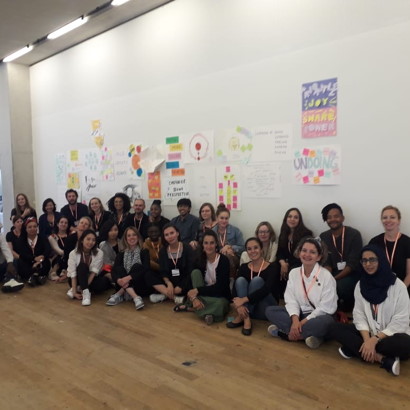
Friends gathered in twos and threes to naturally talk about family, friends, work and hobbies, exchanging positive energy.
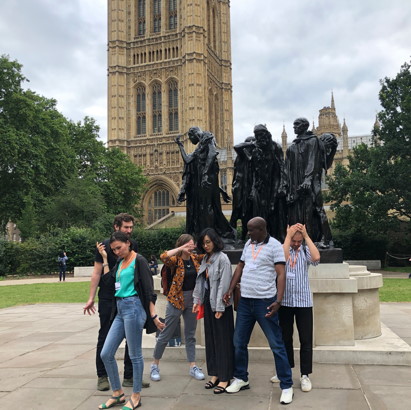
Tours with Tate Exchange members and Inhaus experts
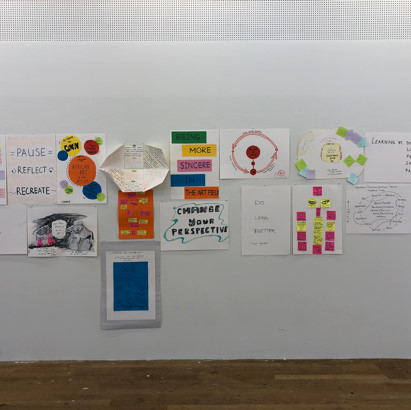
Supervises the International Collection Exhibition Program of Tate, an international initiative program.
As the program runs from 9AM to evening all day long, it is almost difficult to visit local arts museum, gallery, and alternative space during the intensive training. (Many participants told a joke that they might not be able to have enough time to see the collections of Tate Modern which were exhibited in the same building.) Therefore, it is recommended to arrive few days earlier in London before the program starts and find out the local situation of the exhibitions or after the end of the program see new spaces in London which were known through the intensive training or the exhibitions recommended by participated colleagues. I also saw the exhibitions of Serpentine Gallery, ICI, and Hayward Gallery which I had known before the training started. After the end of the course, I visited several spaces where the participants who were active around London had told me and met with persons of interest. The reason to recommend to see the exhibitions in advance is that it is possible to discuss the exhibitions in progress by other institutes during the period of program participation and to establish a network continuously with colleagues of the same interest in the exhibitions through such process.
As the intensive course scheduled tightly for six days required high level of concentration, I tried to prepare an accommodation at the place where to minimize the physical exhaustion. As the lodging cost in downtown London was very expensive, I was able to make a reservation for a suitable accommodation in the aspect of price or location through continuous search in advance. (Located in 10 minutes walking from Tate Modern). Several participants used hotel or Air BNb near the lodge where I stayed. Colleagues who lived with acquaintant in London participated in the course by using public transportations from relatively long distance but found it hard because of rush hour in the morning. In reference, I was able to have a discount from nearby restaurant and arts shop through ID received as a part of the intensive course
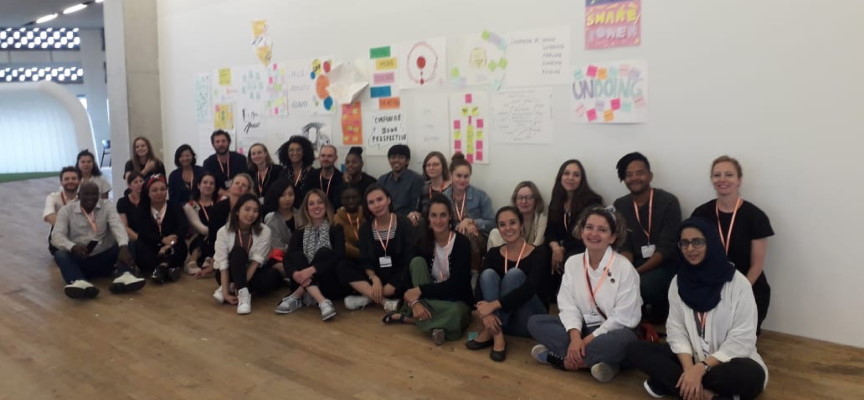
I recommend you to visit new spaces in London, or exhibitions recommended by your colleagues.
Experience at Tate has given us the answer to why it is always mentioned as a major art museum in the world.
”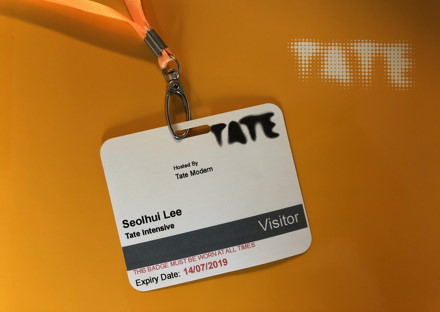
Through the ID paid as part of the Intensive course, discounts were available at nearby restaurants and art shops.
As a Korean curator, it was possible to get a chance to participate in the program thanks to Arko's support.
”The experience in the Tate Modern helped me find a reason why this place had been always mentioned as the world major arts gallery. Especially, through several programs, incessant efforts were produced in the arts gallery which shared their knowhow to create the successful arts gallery with other people and positively reviewed issues newly created through communication process for reprogramming. Most of all, in this place, it was possible to stay afar from old physical, environmental and structural habit accustomed to Korea, to expand the imagination for another leeway created from it, and to dream of the process of a new development considered through self-reflection. I was free. Opening of Olafur Eliasson Exhibition, participation in a lecture held in Turbine Hall, Ai WeiWei whom I met through this time, and appearances of many important figures who continued talking about their own stories freely and comfortably… I suggest those participants in the arts circle whoever need international network or wish to experience overseas arts world. There are many elements to obtain the platforms of exhibition, collection, display research. education, international exchange, program development, and audience response. Lastly, it was possible to obtain an opportunity to participate in the program as a Korean curator thanks to the support of ARKO (different from other participants). I sincerely give thanks
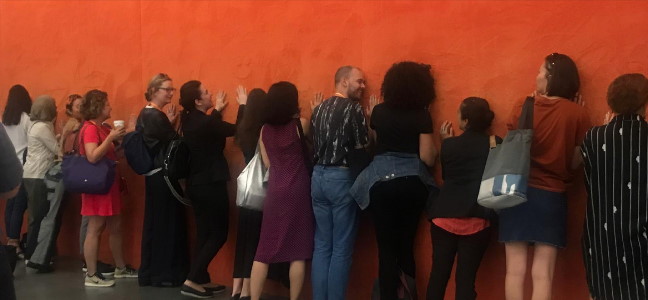
He participated in Marcus Dickey Horley's tour, which plans, manages, and manages public programs for the audience experience and examples of "Accessibility," a concept that has yet to be implemented well while working at a local art museum.